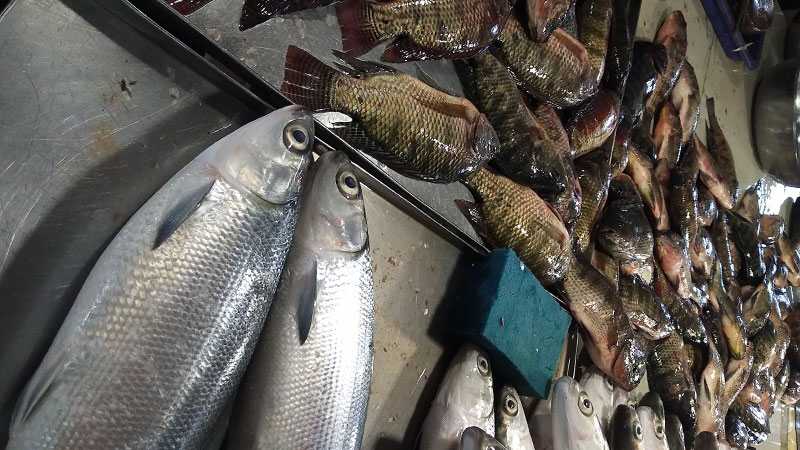Low ‘bangus’ price alarms Pangasinan fish growers

Milkfish or bangus (foreground) has been experiencing seasonal decline in prices for the past four years. —INQUIRER.net photo
DAGUPAN CITY, PANGASINAN, Philippines — Reeling from the continuous tumbling prices of farmed “bangus,” fish cage operators in Pangasinan sought the intervention of the Bureau of Fisheries and Aquatic Resources (BFAR) and other concerned agencies to prevent the province’s multimillion-peso aquaculture industry from crashing.
During a dialogue between bangus industry stakeholders and government agencies on June 21 at the National Fisheries Development Center here, growers of bangus (milkfish) said prices started to drop last February and is now at P90 to P110 per kilo.
Last May, bangus, considered the country’s national fish, was still being sold in Pangasinan markets from P120 to P200 a kilo.
READ: ‘Bangus’ bargain in Pangasinan: Boon or bane?
Christopher Aldo Sibayan, president of the Samahan ng Magbabangus sa Pangasinan, said the price was not even “balik-taya” (breakeven), as it was now below the production cost of P125 to P135 per kilo.
Sibayan added that most were already feeling the effects of their declining profits but were not receiving protection or aid from the government.
He said they have been experiencing a seasonal decline in prices for the past four years.
“But why is this happening? What is lacking and what is not being done? What can the government do so that we won’t experience this season?” he asked at the dialogue.
Pangasinan is famous for its meaty farmed milkfish, and the capital, Dagupan City, holds an annual Bangus Festival to showcase its top product.
BFAR records showed that various milkfish hatcheries in Pangasinan had already produced about 100 million fries annually as early as 2020.
The fish producers begged the different government agencies to act on the pricing of the national fish, saying that while Pangasinan bangus is “world-class,” the “industry can die if the trend continues.”
Ronald Eugenio, a fish cage operator at Sual Mariculture Park, said that if the price decline continues, it could kill the industry in six months.
Oversupply
One of the identified reasons for the dropping prices is the “oversupply” of bangus from the different coastal towns of Pangasinan hosting aquaculture operations, further compounded by producers from other provinces who bring their bangus to Pangasinan to enjoy the “premium name” of the fish culture in the province.
The bangus industry in Pangasinan involves around 9,000 fish producers, but there is no exact data on the total production.
The operators also asked concerned agencies to stop giving permits to more fish cage operations.
Florence Sarmiento, another aquaculture operator, said that there are already 4,000 to 5,000 cages in Anda town alone.
“That’s only in Pangasinan, and there are also fish cages in the southern [provinces of Luzon]. If we can control the number of growers, it would be much better, so we can increase prices a little,” Sarmiento said.
Rosario Segundina Gaerlan, chief of BFAR in the Ilocos region, said his agency could not control the number of cages because the local governments are responsible for giving permits to operators within their municipal waters.
Marvin Quilates of the Department of Agriculture suggested creating a fishery industry council that would involve all stakeholders and monitor and resolve issues regarding the industry, including the production calendar, consolidation of produce, and pricing.
Gaerlan said the council should also include feed providers. Fish producers have said that feeds account for the biggest expense in aquaculture, at about 70 to 80 percent.
The BFAR is currently establishing a community feedmill that would offer low-priced fish feeds formulated by the Southeast Asian Fisheries Development Center, but it can only cater to the needs of aquafarm operators in Bolinao, Pangasinan, where it is located.
Recommendations
Nestor Domenden, the former BFAR-Ilocos regional director who attended the June 21 dialogue, reiterated his call for fish growers to establish a production calendar or schedule their stocking so they would not harvest at the same time and flood the market, bringing down prices.
“You determine the number of producers and then talk among yourselves [about] the schedule of stocking the cages. That way, you won’t be racing against each other,” Domenden advised.
He also recommended the “branding” of Pangasinan bangus to ensure higher prices.
Another suggestion during the dialogue was to establish food terminals in other provinces where bangus is scarce, such as Cagayan, where Pangasinan bangus could be sold.














